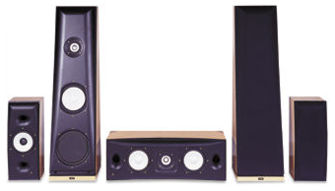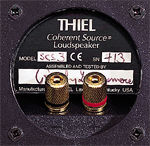Thiel CS2.3, MCS1, and SCS3 Speakers
I've heard too many speakers. After 10 years of reviewing them, it's hard for me to remember what it was like to be surprised . . . astounded . . . amazed by a really good speaker. However, over the past couple of months, I've gotten a taste of what it was like when I first heard good speakers— when I first experienced broad soundstaging, precise imaging, and a neutral, natural tonal balance.

Thiel Audio is a premier high-end speaker brand, a name as revered by audio buffs as Mercedes is by car buffs. The company has built their reputation on their phase-coherent design, which means that the speakers reproduce all frequencies in the same phase, with no phase shift or time delay of any frequency relative to another. Designs that aren't phase-coherent can introduce up to 100 percent phase shift (one full, 360-degree cycle) at some frequencies and almost none at others. How does that translate into sound quality? I'll tell you shortly.
The downside of phase-coherent designs is that they rely on first-order crossovers, which attenuate audio signals by 6 decibels per octave past the crossover point. Higher-order crossovers attenuate the signal much more: 12 dB/ octave in a second-order crossover, 18 dB/octave in a third-order crossover, and so on. The result is that, with a first-order crossover, the drivers have to cover a broader range. Say you've got a two-way speaker with a crossover point at 2.2 kilohertz. The signal going to the tweeter will be attenuated by 6 dB at the crossover point, which means it'll only be attenuated by 12 dB an octave below that at 1.1 kHz. Few tweeters can handle much signal at 1.1 kHz, so they'll likely distort once the volume is turned up past a moderate level.
In my opinion, most speaker makers who are married to the phase-coherent concept just cross their fingers and hope their customers don't turn up their systems. Jim Thiel, however, freely acknowledges the problems inherent in first-order crossovers. "I can't disagree with anything you've said," he once told me in response to a fairly negative article I wrote on the subject. His company now manufactures almost all of their own drivers, so they're able to design drivers specifically to handle the demands created by first-order crossovers. His tweeters, in particular, are unique: They can travel nearly one-fourth of an inch, so they can reproduce frequencies well below 1 kHz without distorting.
OK, let's stop gabbing about crossovers and talk about these speakers. Thiel sent me two of their $3,600/pair CS2.3 tower speakers, three of the $4,400/pair MCS1 left/center/right speakers, and three of the $2,800/pair SCS3 bookshelfs and told me to mix and match them as I saw fit.
 The CS2.3 and MCS1 are more alike than they appear. The CS2.3 has a single 8-inch woofer and a 9-inch passive radiator to reinforce the bass. The MCS1 is a ported, box-shaped speaker with two 6.5-inch woofers. However, both use the same unusual coaxial midrange/tweeter driver. There's only one voice coil for this driver, and it's connected directly to the tweeter dome and the midrange cone through a little ring of flexible material. At high frequencies, only the tweeter dome moves; at lower frequencies, the midrange cone joins in.
The CS2.3 and MCS1 are more alike than they appear. The CS2.3 has a single 8-inch woofer and a 9-inch passive radiator to reinforce the bass. The MCS1 is a ported, box-shaped speaker with two 6.5-inch woofers. However, both use the same unusual coaxial midrange/tweeter driver. There's only one voice coil for this driver, and it's connected directly to the tweeter dome and the midrange cone through a little ring of flexible material. At high frequencies, only the tweeter dome moves; at lower frequencies, the midrange cone joins in.
One big advantage to this design is that the midrange and treble come from the same point. Conventional phase-coherent speakers place the drivers a few inches apart. Thanks to the first-order crossover, both drivers are active over about a four-octave range centered at the crossover point. The distance between them allows one driver to interfere with the other, unless your ears are no more than a couple of inches above or below the ideal listening height. The result is cancellation of some frequencies and reinforcement of others . . . and a very unnatural sound. With Thiel's custom mid/tweet driver, this problem doesn't occur.
- Log in or register to post comments





























































